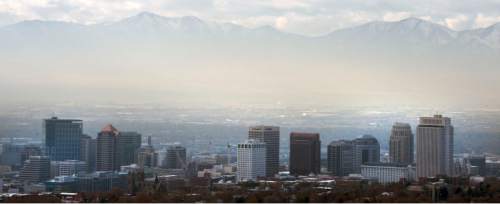This is an archived article that was published on sltrib.com in 2014, and information in the article may be outdated. It is provided only for personal research purposes and may not be reprinted.
Much of the Intermountain West is likely to blow past lower, more stringent limits on ground-level ozone proposed by the Obama Administration.
The U.S. Environmental Protection Agency says the current ozone standard of 75 parts per billion (ppb) is not sufficient and has suggested lowering the limit to 65 to 70 ppb.
The public can comment on the proposed change through the end of February.
Environmentalists applaud the new standard as an important step toward protecting public health and forcing Utah's oil and gas industry to address its emissions problems, particularly in the Uinta Basin where energy production is blamed for some of the nation's highest ozone concentrations.
But state air quality regulators and industry representatives argue Utah's extenuating circumstances — including high levels of background ozone — meaning the state should get a pass.
"For the Mountain West, a challenge is going to be making this a realistic standard, balancing all the different issues to address the concerns and making it work in reality for health concerns and not shutting down a complete state," said Salt Lake City attorney Marie Durrant. "It's going to taking balancing and negotiation. It's going to affect everyone, not just industry."
Following EPA air quality monitoring guidelines, states track hourly ozone levels over eight-hour periods and note the fourth-highest measurement for each year. If that mark exceeds the threshold over three consecutive years, EPA designates the airshed out of attainment.
If the eight-hour standard is lowered to 65 ppb, 53 of 63 monitored western counties would exceed EPA limits, according to an analysis Durrant wrote with colleague Emily Schilling of Holland & Hart, a firm whose clients include Utah counties and industry.
Public health advocates, however, insist more must to be done to reduce ozone near the ground. Ozone in the upper atmosphere protects life from harmful ultraviolet radiation, but no one wants it at nose level.
More than 1,000 recent studies have documented the damage ozone pollution inflicts. High levels eat away at stone buildings and degrade tires. Human lungs are another matter entirely.
Broad compliance with a lowered standard will result in $38 billion in reduced health care costs and prevent up to 4,300 premature deaths, 960,000 asthma attacks, 2,300 bronchitis cases among children and 1 million missed days of school, EPA says.
"Getting that threshold right is so critical. We need to have a clear benchmark," said Jeremy Nichols, energy policy director for WildEarth Guardians. "It's about protecting human health, especially vulnerable people like children and older people. They are trying to heed the call of experts."
States that fall out of attainment are required to develop plans to reduce ozone.
"There is a stigma, but it triggers a mandatory cleanup. I would hate for this to turn into a rhetorical battle where the losers are people who want to breathe clean air," Nichols said. "An ozone standard is a key indicator of how well we are doing to protect our environment. Something has to change on how we power our economy."
Utah and other Western states are expected to insist on special consideration because the region's high elevation and ample sunshine promote ozone formation. And ozone-forming emissions blow in from Southern California and even Asia, studies show.
Ozone is a vastly different pollutant than the fine particulate matter, or PM2.5, that clogs the Wasatch Front during winter inversions. While PM2.5 is a hodgepodge of contaminants that constitute particles under 2.5 microns in diameter, ozone is a highly reactive three-atom string of oxygen.
It doesn't come directly out of tailpipes, but is created during atmospheric mixing of volatile organic compounds and nitrogen oxides, both of which waft out of smokestacks and cars.
Typically, concentrations are worse in summer when high solar angles, long days and hot weather promote the photochemical reactions that form ozone.
However, the Uinta Basin's problems are worse in winter due to the snow cover refracting sunlight back through stagnant air.
Oil and gas industry leaders worry a non-attainment designation will put a damper on their business in east-central Utah. And thanks to efforts to cut particulate emissions on the Wasatch Front, there are not many options left for reducing ozone, short of a ban on driving, Durrant and Schilling say.
Away from Salt Lake and the Uinta Basin, high ozone levels are the result of factors beyond the state's control, according to the Division of Air Quality.
"Our background ozone levels alone can range from 60 to 70 ppb, so we are concerned about how we can protect the health of our residents and meet these stricter standards," the agency's deputy director Brock LeBaron wrote in a blog post this year.
As some EPA critics have posed: What's the point of having a standard that is not possible to meet?
The proposed rule published last month suggests counties can win consideration as "rural transport areas" if they have no emission sources and are not next to a metropolitan area. Special consideration won't exempt counties from the lower standard, but could create exceptions in its implementation.
A final rule will be issued Oct. 1, 2015.
Utah, meanwhile, has started to lean on the oil and gas industry in an effort to hold off a non-attainment designation for the Uinta Basin, which appears inevitable whether or not the ozone standard is lowered.
Two months ago, DAQ toughened standards on the equipment that shuttles and processes hydrocarbons and waste products to curb ozone-forming emissions. But with the Basin's ozone values exceeding 100 ppb in recent years, it is unclear whether those changes will keep EPA from intervening in Uintah and Duchesne counties' air quality problems.



